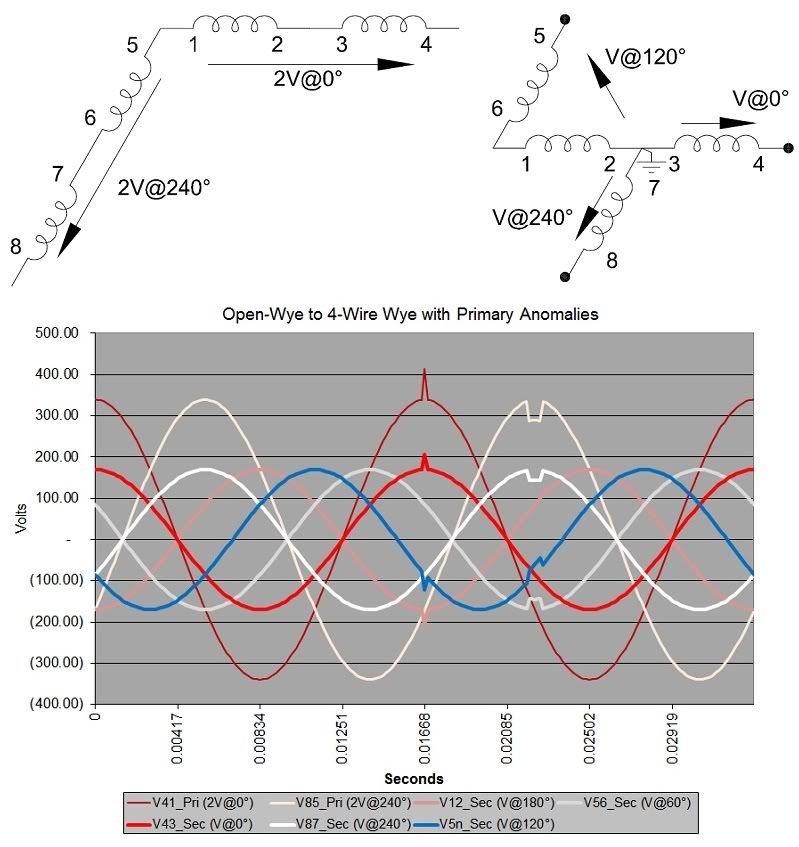The single phase two winding transformer seconday, for illustration, the windings can be extended to infinity in both directions with taps at every winding. For every possible voltage measurement or sum or subtraction of measurements, the solutions always fall on a single line. The geometry of the line is a one dimensional coordinate system and this contains all possible solutions and readings from the above problem. The line is usually referred to as the X axis and measurements are displacement from the origin at x = 0.
There is no need to resort to describing the above solutions in a two dimensional coordinate system, usually referred to as x, y axis or radius, angle in polar coordinates, because there is no displacement or variation in the second dimension. The math reduces to one dimensional analytical solutions (algebra). The variance on the Y axis = 0 and the phase angle variance = 0 (there is none). For all possible solutions and combinations above, all solutions reside along the same line, measureable and describable as displacement along the X axis, with sign positive or negative, simple displacement.
There are no, zero, solutions that have a positive displacement in the Y axis, or, in polar coordinates, a phase rotation angle other than 0 or 180. The 180 deg angle is an artifact of moving from a one dimensional coordinate system that contains all solutions and measurements (a line), to a two dimensional polar coordinate system that has no displacement or variance in the unused second dimension.
This is an application of Occam's Razor, where the simpler of two descriptions is more desirable.
Claiming the above problem set has a solution with a variance or displacement in a second dimension is a false claim. Changing the sign from plus to minus while measuring displacement from the origin along a line (moving in one dimension) does not by itself merit a two dimensional convoluted and misapplied description. This work fails the test of usefulness, which is one of the four tests of the scientific method (Linus Pauling). By extrapolation, work which fails the test of usefulness is not science.
This is for the single iron core two winding transformer secondary with a resistive load (the OP's inquiry). All problems and solutions lay on a single line with a positive or negative displacement about the X axis or line. No problems or solutions lay off of a single line.
Certainly, for other electrical circuits proposed, second iron cores with phase displaced voltage sources, circuits with inductive or capacitive elements, two independent rotating generator sources, adjustable black boxes built to create exactly the effect that is claimed, the solutions to the problem set occur in a two dimensional coordinate system with variances or displacement on the Y axis or rotating phase angles. The two dimensional coordinate system is useful and necessary for describing these problems.
For the problem proposed in the OP of the last four threads, all solutions and descriptions of solutions lay in a one dimensional coordinate system, on a single line with a positive or negative displacement.
Claiming otherwise is the literal equal of saying in response to the question, 'go learn phasor math before you attempt the understanding of the problem that you seek'. It is arrogant and obfuscatory to the petitioner who seeks understanding but lacks training with phasor math. It is an irrelevant and "non" answer. In fact, the second phase angle (180 deg) is an artifact of the coordinate measuring system and not native to the problem or solution that is proposed. All solutions lay in a one dimensional paradigm of understanding. It is a short distance from arrogance and obfuscation to perceived insult. The one dimensional solution or description to the problem is not wrong.



